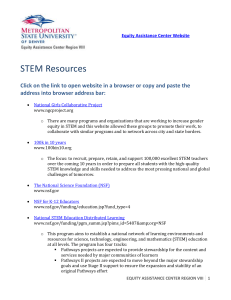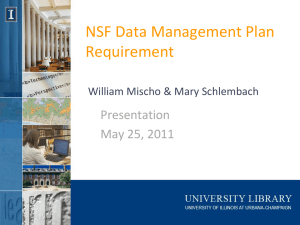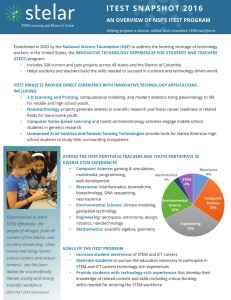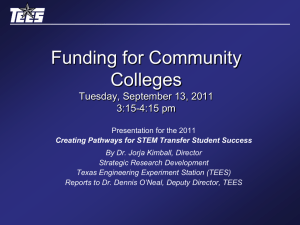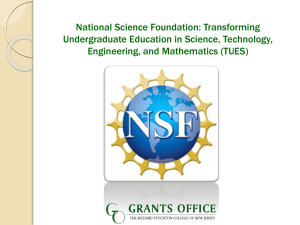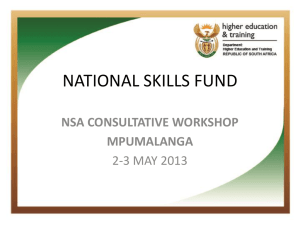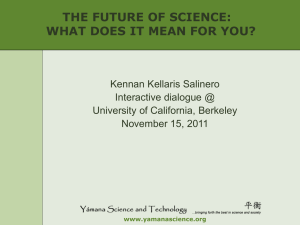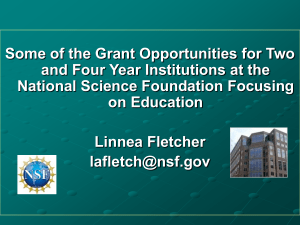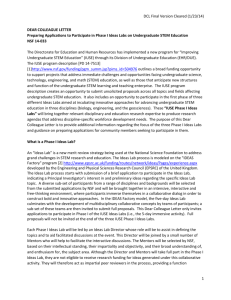NSF Supported After School Programs
advertisement
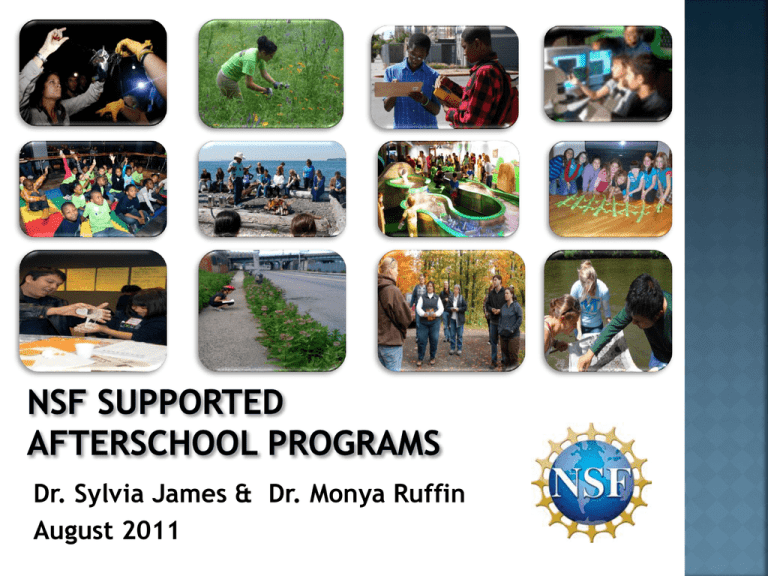
Dr. Sylvia James & Dr. Monya Ruffin August 2011 NSF Strategic Outcome Goals 2011-2015 Transform the Frontiers Innovate for Society Perform as a Model Organization DGE DRK-12 ISE DRL National Science Foundation LLC EHR ITEST DUE REESE HRD R&D to improve effectiveness of STEM learning for people of all ages Advance cutting-edge knowledge and practice in formal and informal settings Support innovative research, development & evaluation of learning and teaching across all STEM disciplines Supports innovation in anywhere, anytime, lifelong learning through investments in research, development, infrastructure, and capacity-building for STEM learning outside formal school settings. ISE Audiences • Public Audiences • Professional Audiences ISE Program Solicitation #: NSF11-546 Permanent and traveling exhibits Film, radio, and TV Cyber-enabled learning, emerging technologies, and educational games Citizen science projects Youth and Community projects Research and development in the field Professional development Consortia and collaborations Virtual networks Research (<$1.5 M) Pathways (<$250 K) Full-Scale Development (<$3 M) Broad Implementation (<$3 M) Connecting Researchers to Public Audiences ($150 K) ````````````````````````` Rapids (<$200 K) EAGERs (<$300 K) Workshops / conferences (Varies) Capital or operating expenses Major or office equipment Vehicles Undergraduate tuition Paid advertising Admission fees Operating expenses for school field trips/camps/ competitions Projects that focus primarily on health or medicine Publications and curricula as the primary deliverable 1. 2. 3. 4. 5. 6. Ubiquity Equity Compelling Experiences Flexible Assessment Abundance of Educators Nimbleness 1. 2. 3. 4. 5. 6. How to bridge for continuity How to capitalize on potential How to support broad learning How to demonstrate learning How to support PD for all How to get coherence of effort # of Projects (n=175) 50 45 40 35 30 25 20 15 10 5 0 Format Type As of 12.10 ISE Impact Categories Awareness, knowledge, or understanding Engagement or interest Attitude Behavior Skills Other (Friedman, 2008; Renninger, 2008) Westat OPMS Pilot Study August 2009 Percent of ISE budget Budget: $64 M Youth/Community: 21.0% Period under review 2005-2007 Sample Active awards Technology Most projects include websites and/or cyberlearning component Outcomes/ Impacts/ Measures 1-4 Impacts identified 100% have formative and summative with complex designs Youth & Community Outcomes Knowledge or comprehension – 75.0% Engagement or Interest – 75.0% Behavior – 25.0% New skills – 25.0% Attitude – 37.5% Include multiple delivery platforms Complex designs with multiple entry points Offer opportunities for long-term interaction Target diverse audiences Include strong partnerships Take place in community settings – local, regional, national Labor intensive Often include professional development and training (PI: Janet Besieger; 08-40313; University of Chicago) is a five -year project designed to introduce middle school students across the country to cryptography and mathematics. Project partners include the Young Peoples Project (YPP), the Museum of Science and Industry in Chicago, and Eduweb. Project deliverables include online activities, online cryptography adventure games, interactive offline games, a leader's manual, and leadership training workshops for afterschool leaders. (PI: Jon Chase; 07-39874; Washington University) This comprehensive five-year project is designed to engage underserved students in grades 11 and 12 in fieldbased exploration of the environment. The four deliverables are as follows: a field program at the Shaw Nature Reserve (SNR), an environmental biology research program, a research communication strategy, and a one-week training experience for science educators to promote dissemination of the program model. Students are introduced to basic ecological concepts, including aquatic biodiversity assessments, species interactions, mark and recapture population studies, population viability exercises, and predator/prey relationships. (06-10720, Bonnie Sawyer, Hopa Mountain) Results of the pre-post surveys indicate a positive shift in thinking about science, along w/ a broader view of science and sharing new knowledge among each other. Students in grades 7-9 gained an appreciation of science. “The lessons being learned through the NSFCs are contributing to the ISE field and articulating ways in which scientific data and traditional knowledge can build collective knowledge bases.” Funded by H-1B visa revenues Focus on any STEM area Targets K-12 students, teachers, and parents in relationship to needs of the US workforce STEM workforce includes technologists, scientists, engineers, and mathematicians; also ICT-intensive fields (e.g., computational biology, biotechnology, and nanotechnology) ITEST Program Solicitation #: NSF 11-525 To produce research findings that build knowledge about approaches, models, and interventions with K-12-aged children and teachers to increase the nation’s capacity and innovation in the STEM workforce of the future. To develop, implement, study and evaluate strategies that encourage K-12 students to develop interest in and to be prepared for careers in the STEM workforce of the future. To equip teachers with the resources to ensure that their students consider choosing and are prepared to enter the STEM workforce of the future. Computer Science – Gaming & Simulations (use Environmental Science includes GIS/GPS, remote sensing technology, climate modeling, and ecological research and analysis and creation of gaming and simulations in formal & informal education) Computer Science includes: programming; web development; multimedia – audio, video and animation; computer hardware; general skills and mathematics Bioscience includes Bioinformatics, biotechnology, DNA analysis/sequencing, and biomedicine Engineering includes Aerospace, design, robotics and nanotechnology Strategies –develop, implement and study theory and practice-based models Scale-Up-expand and study successful models in school and non-school settings Research– produce empirical findings and research tools Conferences and Workshops – define the ITEST research agenda and better understand how to assess impacts of ITEST innovations (PI: Steven Bean, 09-29676, ETR Associates) Formerly Animando a Estudiantes Con Technologia (AET) “Encouraging Students in the Field of Information Technology The PI seeks to test a model of parent engagement and leadership (PEAL) in combination with an out-of-school youth IT education program targeting Latino/a students in middle and high school. Fosters the development of IT fluency and awareness of IT careers PI: Preeti Gupta, 09-29206, New York Hall of Science Virtual Hall of Science (VHOS) serves as a STEM learning environment for middle and high school students. Students use ICT skills to design interactive virtual exhibits, develop digital communication skills, and learn about usability. Participating youth learn interactive computing design, mentoring skills, increased awareness of STEM and ICT careers, teamwork, and leadership skills. Students form teams, create interactive science exhibits, study interactive design, and use a variety of Web 2.0 tools for collaboration purposes. Intellectual Merit How important is the proposed activity to advancing knowledge and understanding within its own field or across different fields? Broader Impacts How well does the activity advance discovery and understanding while promoting teaching, training, and learning? How well does the proposed activity broaden the participation of underrepresented groups (e.g., gender, ethnicity, disability, geographic, etc.)? Ratings: E, VG, G, F, P Solicitations NSF website (www.nsf.gov) Submissions FastLane o Be aware of quirks Grants.gov Electronic ISE Guidelines, NSF 11-546: http://www.nsf.gov/publications/pub_summ.jsp?WT.z_pims_id=5361&ods_ke y=nsf11546 Website: http://www.nsf.gov/funding/pgm_summ.jsp?pims_id=5361&org=D RL&from=home Center for the Advancement of Informal Science Education (CAISE) http://caise.insci.org/ ITEST Guidelines, NSF 11-525 ITEST Homepage http://www.nsf.gov/funding/pgm_summ.jsp?pims_id=5467&org=DRL&from=home ITEST Learning Resource Center website NSF Awards Database <http://www.nsf.gov/awardsearch/ http://www.nsf.gov/pubs/2009/nsf09506/nsf09506.htm http://www2.edc.org/itestlrc/ Dr. Sylvia James Lifelong Learning Cluster Coordinator (703) 292-5333 sjames@nsf.gov Dr. Monya Ruffin Program Officer (703) 292-7322 mruffin@nsf.gov
